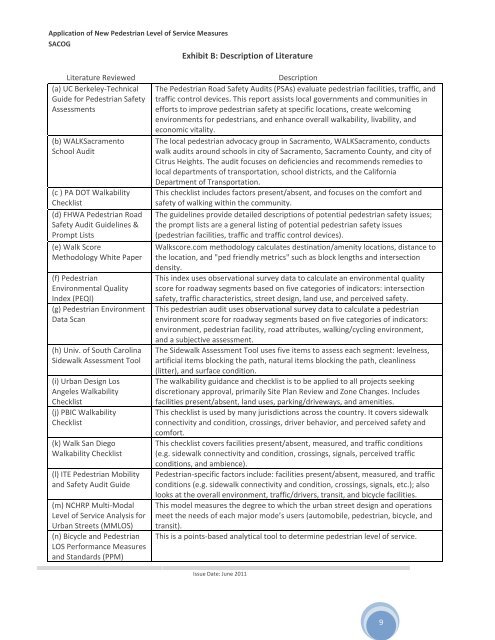Application of New Pedestrian Level of Service Measures - sacog
Application of New Pedestrian Level of Service Measures - sacog
Application of New Pedestrian Level of Service Measures - sacog
Create successful ePaper yourself
Turn your PDF publications into a flip-book with our unique Google optimized e-Paper software.
<strong>Application</strong> <strong>of</strong> <strong>New</strong> <strong>Pedestrian</strong> <strong>Level</strong> <strong>of</strong> <strong>Service</strong> <strong>Measures</strong><br />
SACOG<br />
Exhibit B: Description <strong>of</strong> Literature<br />
Literature Reviewed<br />
(a) UC Berkeley‐Technical<br />
Guide for <strong>Pedestrian</strong> Safety<br />
Assessments<br />
(b) WALKSacramento<br />
School Audit<br />
(c ) PA DOT Walkability<br />
Checklist<br />
(d) FHWA <strong>Pedestrian</strong> Road<br />
Safety Audit Guidelines &<br />
Prompt Lists<br />
(e) Walk Score<br />
Methodology White Paper<br />
(f) <strong>Pedestrian</strong><br />
Environmental Quality<br />
Index (PEQI)<br />
(g) <strong>Pedestrian</strong> Environment<br />
Data Scan<br />
(h) Univ. <strong>of</strong> South Carolina<br />
Sidewalk Assessment Tool<br />
(i) Urban Design Los<br />
Angeles Walkability<br />
Checklist<br />
(j) PBIC Walkability<br />
Checklist<br />
(k) Walk San Diego<br />
Walkability Checklist<br />
(l) ITE <strong>Pedestrian</strong> Mobility<br />
and Safety Audit Guide<br />
(m) NCHRP Multi‐Modal<br />
<strong>Level</strong> <strong>of</strong> <strong>Service</strong> Analysis for<br />
Urban Streets (MMLOS)<br />
(n) Bicycle and <strong>Pedestrian</strong><br />
LOS Performance <strong>Measures</strong><br />
and Standards (PPM)<br />
Description<br />
The <strong>Pedestrian</strong> Road Safety Audits (PSAs) evaluate pedestrian facilities, traffic, and<br />
traffic control devices. This report assists local governments and communities in<br />
efforts to improve pedestrian safety at specific locations, create welcoming<br />
environments for pedestrians, and enhance overall walkability, livability, and<br />
economic vitality.<br />
The local pedestrian advocacy group in Sacramento, WALKSacramento, conducts<br />
walk audits around schools in city <strong>of</strong> Sacramento, Sacramento County, and city <strong>of</strong><br />
Citrus Heights. The audit focuses on deficiencies and recommends remedies to<br />
local departments <strong>of</strong> transportation, school districts, and the California<br />
Department <strong>of</strong> Transportation.<br />
This checklist includes factors present/absent, and focuses on the comfort and<br />
safety <strong>of</strong> walking within the community.<br />
The guidelines provide detailed descriptions <strong>of</strong> potential pedestrian safety issues;<br />
the prompt lists are a general listing <strong>of</strong> potential pedestrian safety issues<br />
(pedestrian facilities, traffic and traffic control devices).<br />
Walkscore.com methodology calculates destination/amenity locations, distance to<br />
the location, and "ped friendly metrics" such as block lengths and intersection<br />
density.<br />
This index uses observational survey data to calculate an environmental quality<br />
score for roadway segments based on five categories <strong>of</strong> indicators: intersection<br />
safety, traffic characteristics, street design, land use, and perceived safety.<br />
This pedestrian audit uses observational survey data to calculate a pedestrian<br />
environment score for roadway segments based on five categories <strong>of</strong> indicators:<br />
environment, pedestrian facility, road attributes, walking/cycling environment,<br />
and a subjective assessment.<br />
The Sidewalk Assessment Tool uses five items to assess each segment: levelness,<br />
artificial items blocking the path, natural items blocking the path, cleanliness<br />
(litter), and surface condition.<br />
The walkability guidance and checklist is to be applied to all projects seeking<br />
discretionary approval, primarily Site Plan Review and Zone Changes. Includes<br />
facilities present/absent, land uses, parking/driveways, and amenities.<br />
This checklist is used by many jurisdictions across the country. It covers sidewalk<br />
connectivity and condition, crossings, driver behavior, and perceived safety and<br />
comfort.<br />
This checklist covers facilities present/absent, measured, and traffic conditions<br />
(e.g. sidewalk connectivity and condition, crossings, signals, perceived traffic<br />
conditions, and ambience).<br />
<strong>Pedestrian</strong>‐specific factors include: facilities present/absent, measured, and traffic<br />
conditions (e.g. sidewalk connectivity and condition, crossings, signals, etc.); also<br />
looks at the overall environment, traffic/drivers, transit, and bicycle facilities.<br />
This model measures the degree to which the urban street design and operations<br />
meet the needs <strong>of</strong> each major mode’s users (automobile, pedestrian, bicycle, and<br />
transit).<br />
This is a points‐based analytical tool to determine pedestrian level <strong>of</strong> service.<br />
Issue Date: June 2011<br />
9
















